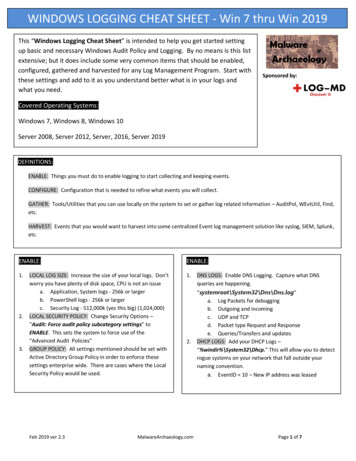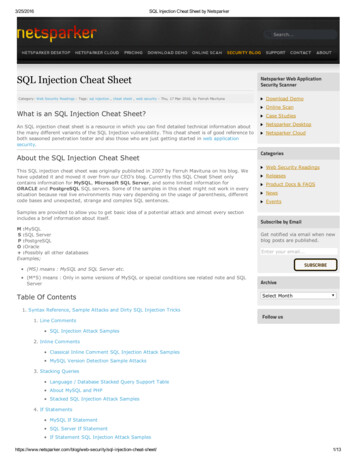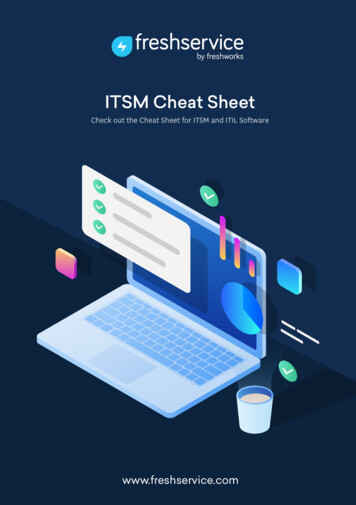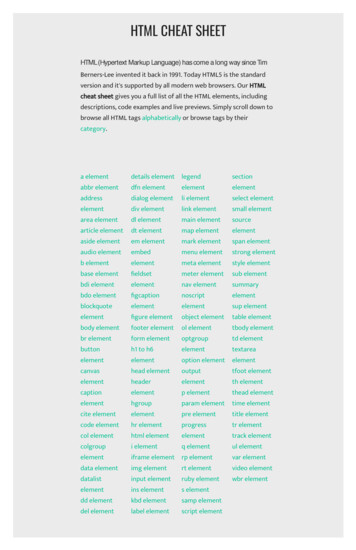
Transcription
YOUR ULTIMATERECRUTINGCHEAT SHEETProven recruiting techniques to optimize your hiring strategy
Chances are, you’re reading this guide because you’ve made the decision to hire. It’s no secret that makingthe wrong hire is expensive. As you probably know, replacing a poor hire within the first six months isestimated to cost 2.5 times the candidate’s salary. Keep them on board beyond six months, and the costgrows exponentially. The key is making the right hire in the first place.In today’s, market with average tenures dropping by nearly 10% each year, traditional recruiting tacticssimply won’t cut it. This guide provides you with proven recruiting techniques to optimize your hiringstrategies.ANTICIPATE & PLAN YOUR STAFFING NEEDSWhen it comes to hiring, most managers start with this question: “Sally just left the marketing team who isgoing to do her job?” This is followed by “Can we afford to replace her?” While the money conversation is avaluable piece of the hiring puzzle, hiring managers should begin instead by asking a more valuablequestion, “Do we have the need to hire, and, if so, what specific skills do we need today?”. It’s important toremember that the department, company, and marketplace have changed from the time you first hiredSally, and now is a good time to assess any skill gaps in your team.Recruiter’s tip: Proactively develop your hiring process so you’re not left in the lurch.Before going to work on your job posting, ask yourself:Is the team meeting the goals and expectations outlined by the company?If not, where are they falling short?Is this gap the result of personnel or procedural issues?Can these gaps be bridged with further training of existing staff or is it time to hire someone new?Will a new hire be an addition to the team or must we let someone go? (Learn when to hire andwhen to fire.)The last, but often overlooked, question is this: What if you don’t hire?Immediate hiring needs are not the only personnel issues to be tackled. Anticipating your future staffingneeds is essential to your recruiting strategy. Study your organization’s long-term business plan. With thatplan in mind, review high and mid-level positions and look ahead. What will your organizational structurelook like in the future? Start identifying the number of employees you will need and in what positions intwo, three, even five years to keep your company and team at the forefront of the marketplace, and on the
road to continued success.As mentioned earlier, the ideal time to recruit new employees is before you actually need them! Spend thetime building your “talent bench” – professionals from your industry, sector, geography, domain, etc. thatwould enhance your team and overall level of expertise were you to hire them down the road. This mayseem very daunting- “I barely have the time to review resumes and interview candidates when a position isopen, where will I find the time to connect with candidates during my normal schedule?” It certainly isn’teasy, but as the labor pool continues to shrink and the demand for high skilled labor increases, it isincumbent upon businesses to maintain an ongoing dialogue with their “dream hires”. Hiring managers andHR professionals should carve out 2-4 hours/month to connect with potential future hires. Incorporatingthis time into your schedule will save both time and money in the long run!Now that you have identified your staffing needs, it is time to build your strategy to attract those dreamhires ATTRACT TOP TALENTThe best and the brightest will not work for mediocre companies. The key to success is to build arelationship with top-performing candidates long before they become applicants. It is your job to showcaseyour stellar employment brand. Studies show a strong employer brand can cut cost per hire by over 50%!Successful employment branding sends a message to the marketplace: WE are THE place to work. Buildyour brand on what makes you a cut above the rest. Emphasize the unique qualities of your corporateculture – Do you offer perks such as alternative scheduling through telecommuting or job sharing? Whatdifferentiates your organization’s philosophy from the competition?You might be surprised to know, compensation is not the primary reason employees leave their jobs.Employees quit managers, not jobs. What makes your organization’s leadership style attractive? How doyou prevent office drama and promote a cohesive, collaborative environment?The answer to these questions and more are the foundation of your organization’s brand. Employers needto understand one key element in today’s world of job search: candidates are investigating yourreputation as diligently as you’re investigating theirs. Do you know how your brand is perceived? Searchsites such as Glassdoor.com, LinkedIn, and even Yelp to see what message is being communicated aboutyour organization as a place to work.
CONNECT WITH TOP TALENTTwo of the most powerful online tools available to promote your organization and attract high-qualityapplicants are your website and your LinkedIn Company Page. Studies show, people make up to thirteenimpressions about someone in the first thirty seconds of interacting with them. In this digital, shortattention-span age, your company website has even less time to make a positive impression. Your site mustgrab your audience’s attention fast and deliver your message even faster.Learn how your website can attract and keep job seekers’ attention.Designing a superior LinkedIn Company Page is your strongest weapon in the war for talent. LinkedIn usersare 8x more engaged with your brand once they’ve connected with you on LinkedIn. Create a CompanyPage that stands out from the competition. Get noticed by showcasing your organization’s mission,expertise, and value proposition. Make it eye-catching and use keyword-rich phrases. Engage with yourfollowers and post relevant content to build your credibility and reputation as an industry thoughtleader. Here are the LinkedIn Secrets you need to bring ideal candidates to your Company Page.WRITE HIGH QUALITY (AND ACCURATE!) JOB DESCRIPTIONSSome employers are under the misconception that writing the Job Description is the “easy part” of hiring.Of course, that might be why so many of them are having trouble finding (and keeping) great talent – theyget lazy when it comes to writing their job specs. A good job description begins with a conversation, not akeyboard.You may be surprised to hear that everyone within your company has a different expectation and needwhen they are making a hire. Competing agendas lead to job descriptions with outlandish and unattainableexpectations. Ultimately, they end up describing three employees in one dooming the entire hiringprocess to fail before it even began.Long before a job is posted, a hiring committee of key stakeholders should come to a consensus about thecore capabilities and expectations. Collectively, they must clearly outline the hard and soft skills ofthe “perfect hire”, goals he or she is expected to meet, and how performance will be measured. Thissuccess profile is essential. Employers cannot develop a job description in a bubble. Stay abreast of thestate of the national hiring market, your local unemployment rate, and high demand skills. Considerthe latest hiring trends in your field, industry, and role to attract the right kind of candidates. These trends
also impact promotion tracks, compensation packages, and other perks – all important pieces of your jobspec.Learn how to create a compensation package fit for an A Player without breaking the bank.Does your compensation package align with the current market? Download our FREE 2018 CompensationGuide and find out!Now that the foundation is in place, it’s time to draft the job posting. Your job descriptions should replacedecades-old headers such as “Requirements” and “Responsibilities” with more engaging language such as“You will be successful in this role if you possess ” and “In this high visibility position, you will impact thebusiness by ” Specifically, be sure to include: A clear picture of your corporate culture The specific activities the new hire will be charged with and how they will impact the business Metrics of success and evaluation Demonstrated skills, relevant experience, and education that will ensure success Ideal personality/soft skill attributes that match your company cultureWhen advising candidates on how to draft a resume, we tell them to remember the 3 Bes. Be succinct. Bespecific. Be truthful. The same goes for employers. Use job, field, or industry-specific keywords to conciselyoutline the qualifications and experience you are looking for. Give an accurate account of expectations andoutcomes.Recruiter’s tip: Do not advertise and hire for one job, then expect your new employee to do something else(it sounds preposterous, but we see it happen all the time).DECIDE WHO’S RUNNING THE SHOWYou’re almost there moments away from taking your search public. Only one question remains: Who’srunning the show? There is nothing more frustrating for all parties involved than a lack of clear leadershipin the search.For the hiring manager, the inability to make decisions causes a number of problems. It undermines herauthority. She is the person on the front lines: monitoring the search, reviewing resumes, identifying viable
candidates, and scheduling and conducting initial interviews. If she has no decision-making authority, shewill be relegated to the role of “Messenger”. This scenario is ripe with potential problems. For every personshe has to get approval from there is the potential for change – changed priorities, changed criteria. Thismuddies the recruiting waters. Suddenly she’s screening for skills or experience that were not on the initiallist. We’ve seen hiring managers and recruiters return again and again to the “well of resumes” as differentmembers of the leadership team suddenly want something new in the candidates they are interviewing –something other than what was agreed to at the outset of the search. In the end, you’re left with a veryfrustrated recruiter and candidate.Speaking of candidates, a lack of clear leadership makes their role in the search frustrating as well. Everyback-and-forth email between the recruiter and higher-ups, adds time to the process. You’re going to losemany strong candidates as they shift their focus to other, more efficient and responsive organizations.Avoid this problem by predetermining which decision makers are involved in the process and who willmanage each part of the search: from marketing to reviewing resumes; to scheduling and participating ininterviews; to who is conducting reference & background checks and ultimately presenting the final offer.This will make your recruiting strategy a well-oiled machine and prevent the loss of excellent candidates.Recruiters tip: It is a candidate’s market. Act fast! Your dream hire will not wait around while every decisionpasses through a long chain of command.MAY WE SUGGEST BRINGING IN AN EXPERT?Did you know one in four employers aren’t sure why they hired the wrong person? Most chalk it up to“sometimes you just make a mistake.” That’s one costly mistake! Engaging with a recruiter will help youavoid the typical hiring mistakes most companies make and significantly increase your chances of makingthe right hire.There are many benefits to working with a retained search firm like TurningPoint Executive Search. Firstand foremost, retained searches yield higher caliber candidates who fit most, if not all of a company’sneeds. Recruiters with a proven track record of making successful placements (and the retention rate toback it up) will help you find new hires that will be successful and are more likely to stay long-term.More often than not, a company will choose to retain an outside recruiting firm, rather than utilizing an inhouse hiring manager exclusively because of the complexity of the role or the organization itself. Retained
recruiters have a deep pool of candidates, many of whom are not actively looking to change jobs. Theseemployed, top-performing, passive candidates can be hard to find. Retained recruiters invest time toresearch and maintain deep networks across industries, domains, and job function. This is a keydifferentiator between hiring managers and executive recruiters, and is extremely important whensearching for uniquely qualified talent or a senior-level, high-salary, pivotal position.Recruiters tip: Investing in a hiring expert with a “partner” mindset, who is knowledgeable across industryand job function will help you find higher caliber candidates.Click here for the 7 Questions You Should Ask Before Choosing a Recruiter.Download our FREE Compensation Sales & Marketing GuideGO LIVE! POST YOUR JOBYou’ve invested many hours to build your recruiting strategy – examining your staffing needs, establishing astrong online presence to attract talent, creating a detailed and accurate job description, and maybe evenhiring an expert to help (hint, hint). It’s finally time to take your job search live.As we’ve mentioned earlier, your company website and LinkedIn page are your biggest allies for attractingthe high-quality candidates you want. Keeping both sites current is the key! You’d be surprised how manycompanies ignore their own Open Jobs page! Don’t let this be you.Use your top-notch Job Description as a marketing tool to attract your dream hires! Market your postingthrough LinkedIn and your company website. Be sure you include easy to follow directions for candidatesto submit resumes. Use your organization’s social media platforms (LinkedIn, Facebook, Twitter, etc.) tokeep your posting in front of your audience. Consider using paid ads, allowing you to market directly yourtarget audience. And don’t forget to make your posting mobile friendly! Nearly 40% of job applications arenow completed via a mobile device. You don’t want to turn off great talent thanks to your outdatedapplication system.Remember to keep your marketing constant and consistent. One update on your LinkedIn page is notenough. Have your entire staff post updates on their social media accounts. Make sure they link to yourcompany’s job page and share what makes your organization such a special place to work.Recruiter’s tip: Encourage your employees to share positive comments on glassdoor and other review sites.Consistency is key. Do not change your submission process. Make sure the steps are clear and easy to
follow. Consider including a brief sentence or two about “next steps” in your hiring process, following theirresume submission. Create an auto response that acknowledges resume submissions to prevent candidatesfrom feeling like their resume disappeared into a black hole never to be seen by a human.IT’S TIME FOR THE DREADED RESUME REVIEW!Ideally, your up-front efforts will make this process easier. Unfortunately, you’re bound to run intoapplicants who ignore your detailed and well thought out job description, treating the “must have”qualifications as more of a guideline. This number should be significantly lower than if you had simplyposted a vague description full of clichés.Depending on the size of your company, you may want to use an Applicant Tracking System (ATS) to helpwade through the resumes you receive. An ATS is a type of software application that sorts through andhouses your submitted resumes. The benefit of using such a system is that it is designed to search for thekeywords and keyword variations you emphasized in your job description. If you are a large company, anATS will come in handy as the number of submissions you receive will be equally largeSmaller companies may choose not to use an ATS at all. No problem! In fact, we are amazed at how oftenwe come across companies that rely on a simple Excel spreadsheet or multiple Word documents. Usingyour keyword-rich job description, create the list of criteria you are searching for in each resume. The morekeywords a resume includes, the more qualified a candidate will be.To best organize the submissions you receive, sort them according to their titles or better yet, theirfunctional expertise. Decide which experiences and skill sets are a must – your “must haves”. Archiveresumes that do not possess those key criteria. You’re bound to have some expectations that are flexible.Perhaps certain training can be provided by your organization, making it reasonable to consider candidatesthat are missing a few qualifications. It should be easy to spot unqualified candidates quickly. Thoserelevant keywords should pop right off the page! If they are nowhere to be seen, the candidate is notviable.Recruiter’s tip: Serious job seekers tailor their resume to include the keywords listed in your job posting.
SOURCING PASSIVE CANDIDATESMany companies rely solely on job boards to secure applicants. While this may seem like an effective andefficient process, it is quite limiting – especially in today’s market of 4.1% unemployment nationally (andhalf that in many key regions of the country). Creating a comprehensive and effective strategy forproactively sourcing candidates from direct competitors has historically been relegated to larger, morecomplex companies with high volume, continual recruiting. Sometimes referred to as “headhunting”, thisprocess may take a bit more time but allows an internal or external recruiter to target ideal candidates,most of whom may not even know you are hiring.Recruiter’s tip: Dream hires aren’t going to see your job posting because they are perfectly happy in theircurrent role.The sourcing process requires the recruiter to search and target candidates using their internal applicantdatabase, LinkedIn, referrals, internal candidates, and employee referrals. Each recruiter will have theirown strategy, but most utilize keywords to narrow the pool. This process puts the hiring power into therecruiter’s hands by targeting high performing, employed, successful talent. Keep in mind, these passivecandidates are not looking for a new job. Therefore, the recruiter & hiring manager will need to spend time“marketing” or “selling” the role and the company to compel the candidate to change positions.Recruiter’s tip: Proactive candidate sourcing allows you to find the “best of the best”, rather than relying on“the best of the available”.THE IMPORTANCE OF PHONE INTERVIEWSPhone screens are an important part of the recruiting process. Most companies do not have the time orresources to conduct in-person interviews for every qualified resume that comes through the door. Thoseare reserved for your top-notch candidates who have shown they are more than keywords on a page. Inorder to find your shining stars, you have to begin with a phone screen.Recruiter’s tip: Partner with an external recruiter and they will take care of the initial screening, allowing thecompany to jump right into “in-person” interviews.Again, do the work ahead of time! Compile a list of suitable questions to ask over the phone to help youquickly identify qualified candidates and eliminate everyone else. Be aware of state and federal lawsregulating what you can ask. Like job seekers, it is extremely important for the interviewer to come to the
conversation prepared! Once you’ve narrowed your pile of resumes to a manageable batch of viableapplicants, use your phone screening questions to begin step one of the interview process. Ideally, thisinitial interview will give the cream of the crop the chance to rise to the top. Be sure to use a consistent setof questions (ideally 10-12) to keep your assessment structured and fair. You want to compare allcandidates on the same criteria.It is your responsibility to review the candidate’s resume and LinkedIn profile before the conversation. Skipvague and generic questions and get right to the nitty-gritty. Ask questions about their background as itpertains to the role they are applying for. Give real-life examples of challenges they will face if they get thejob.Download our FREE Compensation Sales & Marketing GuideBEGIN THE (REAL) INTERVIEW PROCESSAt the completion of your phone interviews, you should have a solid short list of strong candidates. It’s timeto move them to the next step in your hiring process, the in-person interview.It goes without saying, (again) prepare for the interview ahead of time. Decide who will be present. Dividequestions among all the interviewers so each person has the opportunity to connect with the candidate.Give each interviewer a chance to ask questions specific to their expertise and interaction with thecandidate if hired. Prior to launching the interviews, be sure to identify which members of the interviewingcommittee have true “veto power”. This helps to avoid the risk of losing a great candidate simply becauseone of the new hire’s potential peers feels threatened, or even worse, they recommend against making thehire because the candidate reminds them of a former boss, or doesn’t understand the intricacies of thepeer’s unique domain expertise.Corporate culture and “fit” are almost as important as skills and experience. Your interview strategy shouldalso include questions and discussions to gain an understanding of how this person will fit into yourorganization. This piece of your hiring strategy is absolutely critical to find the best applicant for the job.Recruiter’s tip: Using an assessment tool may help you analyze the core behavioral traits which cannot bedemonstrated through a resume or phone interview. For example, a good assessment tool will tell you if theinterviewee is conscientious or lackadaisical, introverted or extroverted, agreeable or uncompromising,open to new ideas or close-minded. The success profile you created early on, will help you determine which
traits are important for each role. However, keep in mind that no assessment is foolproof. Even moreimportant, assessments should be one of many data points to consider when making the ultimate hiringdecision.CHOOSE THE RIGHT CANDIDATEWith a hiring strategy as detailed as the one you created, selecting the best candidate for the role should beeasy. Ideally, your biggest challenge will be choosing which candidate because you have so many to choosefrom! The truth of the matter is, no one will meet all the criteria you are looking for. Luckily, they don’thave to because “close enough” is more than good enough”.With all key stakeholders involved, revisit the job description and the “must haves”. Now ask yourself howmany of those “must haves” are present among your top candidates. Remember, those who did notdemonstrate all of the key technical skills are not automatically out of the race! Ask yourself if it’s possibleto give them the training and guidance necessary to bring them up to speed when they come onboard.More than likely, anyone you hire is going to need training in some areas. What training does yourorganization provide and what would require outsourcing? This will help you decide who is the mostqualified candidate. If you used an assessment tool, compare the results to your target soft skills. If you didnot use an assessment tool, confer with the people who participated in the interview. Did they feel theapplicant demonstrated those soft skills that will ensure a strong culture fit? What did the candidateconvey through their body language, ease of discussion, engagement, listening skills, ability to cite specificexamples and follow up questions?Recruiter’s tip: Don’t panic! Many fear a candidate’s market will force them to hire a less than qualifiedapplicant. In our experience, there are plenty of excellent candidates available. In reality when it comes toselecting your dream hire, “close enough” is more than “good enough.”BEFORE YOU MAKE THE OFFERNo one wants to rescind an offer because of a technicality. Begin with reference checks. Surveys indicate,that while 80% of companies conduct a reference check before making a hire, many complain about thelack of information gathered from the reference. Chances are, they’re doing it wrong. A strategicreference check will give you true insight into a potential hire.
Here are two videos with tips on how to conduct an effective reference check.In addition to reference checks, we suggest completing degree verifications. If a degree is not one of your“must haves”, it’s up to you if you want to validate your candidate’s claim that they have a degree. Again,we strongly recommend doing one.Background checks are becoming more and more common. It’s important to uncover any potentialproblems not revealed by previous testing and interviews.We also suggest visiting your candidate’s social media platforms. While everyone is entitled to privacy and“off time”, your organization may have a morality or behavior clause. Like a background check, social mediaprovides insight into your candidate that was not otherwise evident.Recruiter’s tip: We urge you to develop a detailed social media policy that is clearly documented andcommunicated to all staff.MAKE THE OFFERCongratulations! You’ve found your dream hire and you’re ready to make an offer!Now it’s time to negotiate a compensation package that is competitive, meets your candidate’s financialneeds, and falls within the company’s budget. Take some time to determine the appropriate compensationpackage for the position, considering all aspects of the job (location, travel, upward mobility, the state ofthe business, the expectations of the company, etc.). Before the search was launched, your team probablyset an expected salary range. But remember Candidates have choices. They are no longer feeling the squeeze to accept any role at any amount not willthey take a job for less money (they have too many other options). Few are willing to entertain a lateralmove. This means you must be willing to pay more than they are currently making. On average, we areseeing candidates changing jobs for an increase in base pay of 15-25%. Do your due diligence. Researchwhat other companies are offering for similar roles, years of experience, skill sets, etc. Know thecompetition, determine the minimum the candidate is comfortable with accepting, and the maximum youcan afford to pay. You always want to leave room for negotiating.Recruiters tip: When it comes to compensation packages it may make sense to enlist the support of aseasoned, well-informed compensation consultant to validate the numbers.
When negotiations are done effectively and for the right position, you’ll be adding a rock star to your team.HELP YOUR NEW HIRE FEEL LIKE PART OF THE TEAMYou have invested a significant amount of resource to find the perfect candidate. Now you need to makesure they stick around. Left unsupported and underappreciated, nearly 50% of new hires leave their jobwithin 18 months! It is imperative that you keep your new hires engaged.Retention starts the moment your employees set foot in the office.If you want to attract, engage, and retain top talent, you need an on-boarding program that is ongoing. According to recent research, 69% of businesses do not have a formal new employee on-boardingprocess in place. These companies are all but pushing their new hires out the door.Recruiter’s tip: Clearly defining expectations and means of assessment before day one, affirming theirdecision to join the team and future growth, an introduction to the team and other staff, and even a lattefrom the coffee cart in the lobby will go a long way to ensuring your superstar new hire feels at home fromday one and beyond.Find out how effective your Onboarding Program is by reading up on the latest research.
something other than what was agreed to at the outset of the search. In the end, you're left with a very frustrated recruiter and candidate. Speaking of candidates, a lack of clear leadership makes their role in the search frustrating as well. Every back-and-forth email between the recruiter and higher-ups, adds time to the process.










